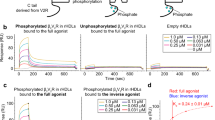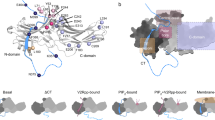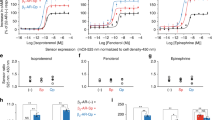Abstract
Signals from 800 G-protein-coupled receptors (GPCRs) to many SH3 domain-containing proteins (SH3-CPs) regulate important physiological functions. These GPCRs may share a common pathway by signaling to SH3-CPs via agonist-dependent arrestin recruitment rather than through direct interactions. In the present study, 19F-NMR and cellular studies revealed that downstream of GPCR activation engagement of the receptor-phospho-tail with arrestin allosterically regulates the specific conformational states and functional outcomes of remote β-arrestin 1 proline regions (PRs). The observed NMR chemical shifts of arrestin PRs were consistent with the intrinsic efficacy and specificity of SH3 domain recruitment, which was controlled by defined propagation pathways. Moreover, in vitro reconstitution experiments and biophysical results showed that the receptor–arrestin complex promoted SRC kinase activity through an allosteric mechanism. Thus, allosteric regulation of the conformational states of β-arrestin 1 PRs by GPCRs and the allosteric activation of downstream effectors by arrestin are two important mechanisms underlying GPCR-to-SH3-CP signaling.
This is a preview of subscription content, access via your institution
Access options
Access Nature and 54 other Nature Portfolio journals
Get Nature+, our best-value online-access subscription
$29.99 / 30 days
cancel any time
Subscribe to this journal
Receive 12 print issues and online access
$259.00 per year
only $21.58 per issue
Buy this article
- Purchase on Springer Link
- Instant access to full article PDF
Prices may be subject to local taxes which are calculated during checkout






Similar content being viewed by others
References
Furness, S. G. et al. Ligand-dependent modulation of G protein conformation alters drug efficacy. Cell 167, 739–749.e11 (2016).
Flock, T. et al. Selectivity determinants of GPCR-G-protein binding. Nature 545, 317–322 (2017).
Flock, T. et al. Universal allosteric mechanism for Gα activation by GPCRs. Nature 524, 173–179 (2015).
Venkatakrishnan, A. J. et al. Diverse activation pathways in class A GPCRs converge near the G-protein-coupling region. Nature 536, 484–487 (2016).
Isogai, S. et al. Backbone NMR reveals allosteric signal transduction networks in the β1-adrenergic receptor. Nature 530, 237–241 (2016).
Sounier, R. et al. Propagation of conformational changes during μ-opioid receptor activation. Nature 524, 375–378 (2015).
Komolov, K. E. et al. Structural and functional analysis of a β2-adrenergic receptor complex with GRK5. Cell 169, 407–421.e16 (2017).
Homan, K. T. & Tesmer, J. J. Structural insights into G protein-coupled receptor kinase function. Curr. Opin. Cell Biol. 27, 25–31 (2014).
Reiter, E. & Lefkowitz, R. J. GRKs and β-arrestins: roles in receptor silencing, trafficking and signaling. Trends Endocrinol. Metab. 17, 159–165 (2006).
Kumari, P. et al. Functional competence of a partially engaged GPCR-β-arrestin complex. Nat. Commun. 7, 13416 (2016).
Yang, F. et al. Phospho-selective mechanisms of arrestin conformations and functions revealed by unnatural amino acid incorporation and 19F-NMR. Nat. Commun. 6, 8202 (2015).
Dong, J.-H. et al. Adaptive activation of a stress response pathway improves learning and memory through Gs and β-arrestin-1-regulated lactate metabolism. Biol. Psychiatry 81, 654–670 (2017).
Lefkowitz, R. J. & Shenoy, S. K. Transduction of receptor signals by β-arrestins. Science 308, 512–517 (2005).
Liu, C. H. et al. Arrestin-biased AT1R agonism induces acute catecholamine secretion through TRPC3 coupling. Nat. Commun. 8, 14335 (2017).
Shukla, A. K. et al. Visualization of arrestin recruitment by a G-protein-coupled receptor. Nature 512, 218–222 (2014).
Wang, W., Qiao, Y. & Li, Z. New insights into modes of GPCR activation. Trends Pharmacol. Sci. 39, 367–386 (2018).
Luttrell, L. M. et al. β-Arrestin-dependent formation of β2 adrenergic receptor-Src protein kinase complexes. Science 283, 655–661 (1999).
Hara, M. R. et al. A stress response pathway regulates DNA damage through β2-adrenoreceptors and β-arrestin-1. Nature 477, 349–353 (2011).
Xiao, K. et al. Functional specialization of β-arrestin interactions revealed by proteomic analysis. Proc. Natl Acad. Sci. USA 104, 12011–12016 (2007).
Miller, W. E. et al. β-Arrestin1 interacts with the catalytic domain of the tyrosine kinase c-SRC. Role of β-arrestin1-dependent targeting of c-SRC in receptor endocytosis. J. Biol. Chem. 275, 11312–11319 (2000).
Tobin, A. B., Butcher, A. J. & Kong, K. C. Location, location, location…site-specific GPCR phosphorylation offers a mechanism for cell-type-specific signalling. Trends Pharmacol. Sci. 29, 413–420 (2008).
Peterson, Y. K. & Luttrell, L. M. The diverse roles of arrestin scaffolds in G protein-coupled receptor signaling. Pharmacol. Rev. 69, 256–297 (2017).
Shukla, A. K. et al. Distinct conformational changes in β-arrestin report biased agonism at seven-transmembrane receptors. Proc. Natl Acad. Sci. USA 105, 9988–9993 (2008).
Lee, M. H. et al. The conformational signature of β-arrestin2 predicts its trafficking and signalling functions. Nature 531, 665–668 (2016).
Nuber, S. et al. β-Arrestin biosensors reveal a rapid, receptor-dependent activation/deactivation cycle. Nature 531, 661–664 (2016).
Shukla, A. K. et al. Structure of active β-arrestin-1 bound to a G-protein-coupled receptor phosphopeptide. Nature 497, 137–141 (2013).
Kang, Y. et al. Crystal structure of rhodopsin bound to arrestin by femtosecond X-ray laser. Nature 523, 561–567 (2015).
Cahill, T. J. III et al. Distinct conformations of GPCR-β-arrestin complexes mediate desensitization, signaling, and endocytosis. Proc. Natl Acad. Sci. USA 114, 2562–2567 (2017).
Kim, Y. J. et al. Crystal structure of pre-activated arrestin p44. Nature 497, 142–146 (2013).
Manglik, A. et al. Structural insights into the dynamic process of β2-adrenergic receptor signaling. Cell 161, 1101–1111 (2015).
Hanson, S. M. et al. Structure and function of the visual arrestin oligomer. EMBO J. 26, 1726–1736 (2007).
Gurevich, V. V. & Gurevich, E. V. The molecular acrobatics of arrestin activation. Trends Pharmacol. Sci. 25, 105–111 (2004).
Kim, M. et al. Conformation of receptor-bound visual arrestin. Proc. Natl Acad. Sci. USA 109, 18407–18412 (2012).
Liu, J. J., Horst, R., Katritch, V., Stevens, R. C. & Wthrich, K. Biased signaling pathways in β2-adrenergic receptor characterized by 19F-NMR. Science 335, 1106–1110 (2012).
Taniguchi, K. et al. A gp130-Src-YAP module links inflammation to epithelial regeneration. Nature 519, 57–62 (2015).
Rahmeh, R. et al. Structural insights into biased G protein-coupled receptor signaling revealed by fluorescence spectroscopy. Proc. Natl Acad. Sci. USA 109, 6733–6738 (2012).
Yang, Z. et al. Phosphorylation of G protein-coupled receptors: from the barcode hypothesis to the flute model. Mol. Pharmacol. 92, 201–210 (2017).
Hirsch, J. A., Schubert, C., Gurevich, V. V. & Sigler, P. B. The 2.8 A crystal structure of visual arrestin: a model for arrestin’s regulation. Cell 97, 257–269 (1999).
Brown, M. T. & Cooper, J. A. Regulation, substrates and functions of src. Biochim. Biophys. Acta 1287, 121–149 (1996).
Xu, W., Harrison, S. C. & Eck, M. J. Three-dimensional structure of the tyrosine kinase c-Src. Nature 385, 595–602 (1997).
Sicheri, F., Moarefi, I. & Kuriyan, J. Crystal structure of the Src family tyrosine kinase Hck. Nature 385, 602–609 (1997).
Changeux, J. P. & Christopoulos, A. Allosteric modulation as a unifying mechanism for receptor function and regulation. Cell 166, 1084–1102 (2016).
DeVree, B. T. et al. Allosteric coupling from G protein to the agonist-binding pocket in GPCRs. Nature 535, 182–186 (2016).
Bourquard, T. et al. Unraveling the molecular architecture of a G protein-coupled receptor/β-arrestin/Erk module complex. Sci. Rep. 5, 10760 (2015).
Fessart, D. et al. Src-dependent phosphorylation of β2-adaptin dissociates the β-arrestin-AP-2 complex. J. Cell Sci. 120, 1723–1732 (2007).
Ruschak, A. M. & Kay, L. E. Proteasome allostery as a population shift between interchanging conformers. Proc. Natl Acad. Sci. USA 109, E3454–E3462 (2012).
Tugarinov, V., Sprangers, R. & Kay, L. E. Probing side-chain dynamics in the proteasome by relaxation violated coherence transfer NMR spectroscopy. J. Am. Chem. Soc. 129, 1743–1750 (2007).
Barker, S. C. et al. Characterization of pp60c-src tyrosine kinase activities using a continuous assay: autoactivation of the enzyme is an intermolecular autophosphorylation process. Biochemistry 34, 14843–14851 (1995).
Carducci, M. et al. The protein interaction network mediated by human SH3 domains. Biotechnol. Adv. 30, 4–15 (2012).
Edgar, R. C. MUSCLE: multiple sequence alignment with high accuracy and high throughput. Nucleic Acids Res. 32, 1792–1797 (2004).
Kumar, K. V., Modi, K. D. & Kalra, S. Mighty journals, mega trials, and modest points. Indian J. Endocrinol. Metab. 20, 578–579 (2016).
Huerta-Cepas, J., Serra, F. & Bork, P. ETE 3: reconstruction, analysis, and visualization of phylogenomic data. Mol. Biol. Evol. 33, 1635–1638 (2016).
Rasmussen, S. G. et al. Crystal structure of the human β2 adrenergic G-protein-coupled receptor. Nature 450, 383–387 (2007).
Liang, Y.-L. et al. Phase-plate cryo-EM structure of a class B GPCR-G-protein complex. Nature 546, 118–123 (2017).
Loudon, R. P. & Benovic, J. L. Expression, purification, and characterization of the G protein-coupled receptor kinase GRK6. J. Biol. Chem. 269, 22691–22697 (1994).
Kim, T. H. et al. The role of ligands on the equilibria between functional states of a G protein-coupled receptor. J. Am. Chem. Soc. 135, 9465–9474 (2013).
Li, H. et al. Crystal structure and substrate specificity of PTPN12. Cell Rep. 15, 1345–1358 (2016).
Li, R. et al. Molecular mechanism of ERK dephosphorylation by striatal-enriched protein tyrosine phosphatase. J. Neurochem. 128, 315–329 (2014).
Majkut, J. et al. Differential affinity of FLIP and procaspase 8 for FADD’s DED binding surfaces regulates DISC assembly. Nat. Commun. 5, 3350 (2014).
Kim, Y., Rice, A. E, & Denu, J. M. Intramolecular dephosphorylation of ERK by MKP3. Biochemistry 42, 15197–15207 (2003).
Acknowledgements
We thank D.-S. Li for stimulating discussions and critical reading of the manuscript. We thank S.-S. Zang and X-H. Liu of the Core Facility of Protein Research, Institute of Biophysics, Chinese Academy of Sciences, for their help in the NMR data collection, analysis and valuable discussion. We thank J. Jia and S. Sun for their technical assistance in flow cytometry analysis. We thank X. Ding from the Laboratory of Proteomics, Core Facilities for Protein Science, at the Institute of Biophysics (IBP), Chinese Academy of Sciences (CAS), for her help with the mass spectrometry analysis. We thank R.J. Lefkowitz (Duke University) for giving the constructs of Flag-β2AR, Flag-V2R, Flag-SSTR2, β-arrestin-1-YFP, GRK6-YFP and GRK2-YFP. We thank Z. Yang, Y.-S. He, X.-L. Fu and L. Chen for participating in the collection and analysis of this large sequence library of GPCRs. We thank an anonymous scientist who helped in design of the receptor–arrestin–SRC complex formation strategy and contributed significantly to this project. We acknowledge support from the National Key Basic Research Program of China (2015CB856203 to J.-Y.W.), the National Natural Science Foundation of China (81773704 and 31470789 to J.-P.S., 21325211 to J.-Y.W., 31700692 to P.X.), the Shandong Natural Science Fund for Distinguished Young Scholars (JQ201517 to J.-P.S.), the Fundamental Research Fund of Shandong University (2014JC029 to X.Y.), the National Science Fund for Distinguished Young Scholars (81525005 to F.Y.) and the Program for Changjiang Scholars and Innovative Research Team in University (IRT13028).
Author information
Authors and Affiliations
Contributions
J.-P.S. conceived the idea for allosteric regulatory mechanism of arrestin and its engagement with effectors. J.-Y.W. conceived all chemical biology experiments and synthesis route. J.-P.S. conceived that majority of GPCR members connect to SH3-domain-containing proteins through arrestins. J.-Y.W. brought up the idea for F2Y and KPN. J.-P.S, F. Yang and P.X. designed the key experiments to dissect the allosteric propagation pathways. J.-P.S., J.-Y.W. and X.Y. designed most of the experiments. F. Yang and K.R. collected and analyzed the 19F-NMR data. P.X., Q. Liu. and F. Yang purified β2AR and GRK6 proteins. P.X., C.-X.Q and F. Yang performed SRC kinase activity assays. Q. Liu Synthesized TA-bimane and performed fluorescence spectroscopy assays. Z.-X.L. performed BRET assays. F. Yang, C.-X.Q., C.L., R.-R.L., Y.-M.S. Z.-Y.Y and X.-Z.G. synthesized F2Y and purified F2Y incorporated β-arrestin 1 proteins. F. Yang, C.L. and Q.-T.H. purified GST-SRC-FL, GST-SH3-CPs and GST-clathrin proteins. F. Yang, P.X. C.-X.Q., Q.-T.H. and Q. Li. performed GST-pull down and CO-IP assays. F. Yang and Q.-T.H. performed circular dichroism assays. F. Yang, F. Yi and Q. Li performed Trypsin digestion and MS/MS assays. L.-Y.W., P.X., C.-X.Q., J.-Y.X. and D.-F.H., analyzed the SH3 binding motif (proline region) across GPCR family members. J.-P.S., J.-Y.W. and X.Y. supervised the overall project design and execution. J.-P.S. participated in data analysis and interpretation. J.-P.S. and J.-Y.W. wrote the manuscript. All of the authors have seen and commented on the manuscript.
Corresponding authors
Ethics declarations
Competing interests
The authors declare no competing interests.
Additional information
Publisher’s note: Springer Nature remains neutral with regard to jurisdictional claims in published maps and institutional affiliations.
Supplementary information
Supplementary Text and Figures
Supplementary Figures 1–39
Supplementary Note 1
Sequence information for the localization of the proline region in the intracellular region of GPCR members; Supplementary methods; Additional Supplemental Figure
Rights and permissions
About this article
Cite this article
Yang, F., Xiao, P., Qu, Cx. et al. Allosteric mechanisms underlie GPCR signaling to SH3-domain proteins through arrestin. Nat Chem Biol 14, 876–886 (2018). https://doi.org/10.1038/s41589-018-0115-3
Received:
Accepted:
Published:
Issue Date:
DOI: https://doi.org/10.1038/s41589-018-0115-3
This article is cited by
-
Distinct activation mechanisms of β-arrestin-1 revealed by 19F NMR spectroscopy
Nature Communications (2023)
-
QR code model: a new possibility for GPCR phosphorylation recognition
Cell Communication and Signaling (2022)
-
Structural studies of phosphorylation-dependent interactions between the V2R receptor and arrestin-2
Nature Communications (2021)
-
Activation pathway of a G protein-coupled receptor uncovers conformational intermediates as targets for allosteric drug design
Nature Communications (2021)
-
Cartilage oligomeric matrix protein is an endogenous β-arrestin-2-selective allosteric modulator of AT1 receptor counteracting vascular injury
Cell Research (2021)



